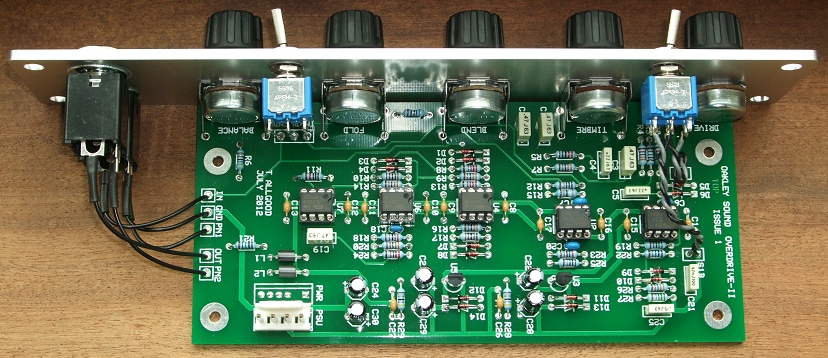
PCBs for this module are now discontinued

The Oakley Overdrive-II features two different waveform modifiers to produce a wide range of overdriven and distortion sounds.
The first waveform modifier is a classic overdrive circuit which can produce a sound that is familiar to many guitarists. The original issue Oakley Overdrive module contained only this part. The circuit has two basic modes selected by a switch. 'Hard' is a raucous distortion type effect useful for grunging up your signal. 'Soft' is a more subtle effect and produces a clean sounding overdriven amp sound.
Three front panel pots control the sound in this section. Drive controls the overall gain of the circuit’s 'pre-amplifier' stage and essentially determines the level of overdrive or distortion. Timbre is an effective tone control that cuts or accentuates the additional harmonics produced by the pre-amplifier stage. And the Blend pot is essentially a wet/dry mix control that allows you to add only as much of the effect as you want.
The second waveform modifier is a harmonic multiplier. This part of the module produces additional harmonics by folding over the input signal so that the tops and bottoms of the waveform are forced the wrong way. This produces strident changes in tone that are dependant on the signal level. Up to two stages of symmetrical folding are available and at the output there is a soft clipping circuit to prevent excessive folding at extreme input levels.
Two front panel pots affect the action of this circuit. Foldover adjusts the gain of the harmonic multiplier and controls the amount of folding the input signal will be subjected to. The Balance control is another wet/dry control so that you can mix the output of the overdrive circuit with the harmonic multiplier.
The input/blend switch selects whether the input to the harmonic multiplier comes directly from the input socket or the overdrive circuit. Thus the two modifiers in this module can be operated in series or in parallel. In conjunction with the blend and balance pots you can create a wide variety of different tones.
Voltage control is determined not within this unit, but as part of the signal chain placed before this module. Using a VCA to control the signal level that is fed into this unit will determine the strength of the overdrive, distortion or folding. Using a VCF to alter the timbre of the signal fed to this module will control the overall harmonic level far more than using a filter alone. In fact, hard sync type sounds can be easily obtained by simply sweeping the filter's cut-off frequency.
The module accommodates either our standard Oakley/MOTM power header or a Synthesizers.com power header. Current draw is approximately 25mA per rail.
The PCB is 66mm (deep) x 158mm (height). The five pots are normally board mounted for speed and simplicity
As with all Oakley projects the PCB is double sided with through plated holes, has tough solder mask both sides, and has bold component legending for ease of construction.

The Overdrive-II in a natural finish MOTM format front panel.
Sound Samples
A single Oakley VCO on sawtooth driving a TSL which in turn feeds the Overdrive-II module. The output of the Overdrive is fed to the final ADSR/VCA and out to the DAW. A simple 3/16th & 6/16th delay is applied to the sequence for the Berlin School feel.
The track features a simple eight note sequence. There are essentially four parts of more or less equal length but recorded as one long piece. The first three parts start with the dry sound coming out of the filter. The first part is overdrive, the second is distortion, the third is the harmonic multiplier on its own, and then the fourth part starts as the harmonic multiplier is now driven from the overdrive section.
In each section I play with the various controls on the Overdrive-II module and occasionally tweak the filter's cut-off and resonance controls a bit. It's worth downloading the file as the real time streaming sound quality is not that great.
The next set of samples were recorded using a small modular set up comprising of one VCO, one COTA filter, one original Overdrive module, two ADSR/VCA and a midiDAC to control them all. The Oakley Overdrive module is connected to the -24dB/octave output of the COTA VCF module and its output is fed to the ADSR/VCA module for final volume shaping.
A lightly overdriven solo sound using the COTA VCF to shape the harmonics heard
More overdrive with the COTA set to highish resonance and swept with an ADSR, firstly on slow attack, then quicker.
A small sequenced loop with the Overdrive module in distortion mode. The wet-dry pot and COTA's cut-off are being manually altered
Project Downloads
Construction Guide Our handy guide to building Oakley DIY projects
Parts Guide Our handy guide to buying parts for Oakley DIY projects
Links to schematics are available to purchasers of the PCB or module and will be sent via e-mail when the board(s) are shipped.
Front Panel database
A Schaeffer front panel can be made for the 1U wide 5U high Overdrive module in traditional black or in natural aluminium finish. The databases can be found by downloading the following links:
Overdrive-II in traditional black
Overdrive-II in natural silver
To read these files you will need a copy of 'Frontplatten designer' from Schaeffer. The program also features on-line ordering, so its now even easier to buy your panels from Scheaffer.
The company are based in Berlin in Germany and will send out panels to anywhere in the world. Delivery to the UK normally takes around ten days. For North American users you can also order your Schaeffer panels from Front Panel Express.
Back home